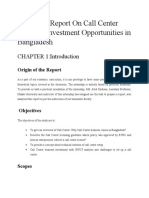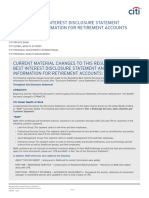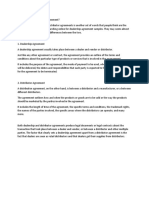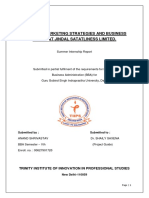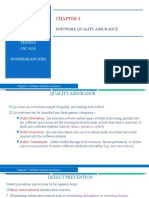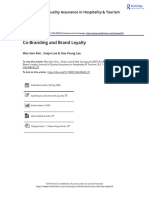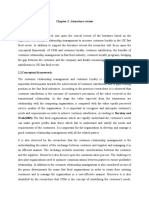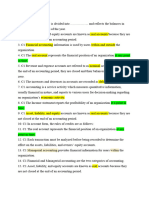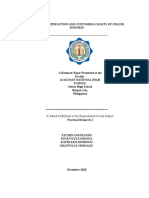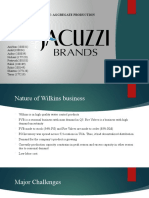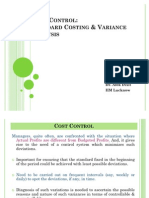Customer Retention Research
Customer Retention Research
Uploaded by
Mikael OpokuCopyright:
Available Formats
Customer Retention Research
Customer Retention Research
Uploaded by
Mikael OpokuOriginal Description:
Original Title
Copyright
Available Formats
Share this document
Did you find this document useful?
Is this content inappropriate?
Copyright:
Available Formats
Customer Retention Research
Customer Retention Research
Uploaded by
Mikael OpokuCopyright:
Available Formats
2.4 Customer Retention Customer retention involves the steps taken by a selling organisation in order to reduce customer defection.
Successful customer retention starts with the first contact an organization has with a customer and continues throughout the entire lifetime of a relationship. Customer retention is important to most companies because the cost of acquiring a new customer is far greater than the cost of maintaining a relationship with a current customer (Ro King, 2005). Several studies put emphasis on the significance of customer retention in the banking industry (Dawkins and Reichheld, 1990).
The argument for customer retention is relatively straightforward. It is more economical to keep customers than to acquire new ones. The costs of acquiring customers to replace those who have been lost are high. This is because the expense of acquiring customers is incurred only in the beginning stages of the commercial relationship (Reichheld and Kenny, 1990). In addition, longerterm customers buy more and if satisfied may generate positive word-of mouth promotion for the company. Additionally, long-term customers also take less of the companys time and are less sensitive to price changes (Healy, 1999). These findings highlight the opportunity for management to acquire referral business, as it is often of superior quality and inexpensive to obtain. Thus, it is believed that reducing customer defections by as little as five percent can double the profits (Healy, 1999). 2.4.1 Customer lifetime value: Thompson & Martin (2005) explain that every interaction with a customer should be done on the basis that their value to you is the total of all the purchases they will ever make, not that one sale. As an example, they state that most valuable customers are probably not those who make the biggest purchases; they are the ones who come back again and again. This way of thinking, according to him, enables firms to consider marketing approaches that dont require firms to make back the cost of acquiring a customer in a single sale. 2.4.2The cost of acquisition: According to Porter, it has been demonstrated that it is up to 20 times more expensive to acquire a new customer than it is to keep an existing one. De Wit & Meyer (2004) say that a traditional sales approach can be likened to pouring new customers into a bucket with a hole in the bottom the weaker your levels of customer retention the larger the hole.
2.5 Influential Factors of Customer Retention The increasing competitiveness in the financial service industry is forcing organisations to place greater emphasis on building and establishing valuable customer relationship (Oracle Corporation, 2005). According to Canel, Rosen and Anderson (2000), considering the situation from a wider perspective maintained that with the expanding global competition, the emergence of new technology and improved communication have increased customers expectation for fuller
satisfaction on their investment. A companys ability to attract and retain new customers is not only related to its product or service, but strongly related to the way it services existing customers and the reputation it creates within and across the market place.
2.5.1 Service Quality The key factors influencing customers selection of a bank include the range of services, rates, fees and prices charged (Abratt and Russell, 1999). It is apparent that superior service alone is not sufficient to satisfy customers. Prices are essential, if not more important than service and relationship quality. Furthermore, service excellence, meeting client needs, and providing innovative products are essential to succeed in the banking industry. Most private banks claim that creating and maintaining customer relationships are important to them and they are aware of the positive values that relationships provide (Colgate et al., 1996). Customers do not remain with an organisation just because of the discount offered or loyalty programme that is available. The service provided must also meet the expectations of the customer. An organisation building customer retention should enable customers to receive what they want, when they want it (just in time) and a perfect delivery each and every time with the desired level of service that appeal to the customer (Gronroos, 1997). Phelps and Graham (2001) also enumerated the two most effective methods of generating increased sales and customer retention as follows: (a) Give the customer a superior experience that they have no reason to or even look elsewhere. (b) Give them incentives to spend more, return, refer or buy more frequently. 2.5.2 Customer Loyalty Customer retention is more than giving the customer what they expect; its about exceeding their expectation so that they become loyal advocates for your brand. Creating customer loyalty puts customer value rather than maximizing profit and shareholder value at the centre of business strategy. The key differentiator in a competitive environment is more often than not the delivery of a consistently high standard of customer service (ibid). Customer loyalty is the heart of retention. If an organisation is not able to keep customer and build long-term relationship, it will continue to operate with discrete one off transaction. Discussion of customer retention seem to be dominated by loyalty programmes and customer discounts. But research shows that what really makes a customer to re-purchase is high quality customer service and well managed formal and informal communication (Mcllroy and Barnett, 2000). Customer loyalty is strongly associated with customers willingness to continue in the relationship; however, customer switching behaviour has a direct and strong effect on loyalty (Rowley, 2002). Loyalty can be understood in different ways depending upon the nature of the product or service which is being offered to a customer. For example, a bank customer is typically loyal as long as he holds an account with a bank and switches
when he changes his account. Furthermore, a customer can demonstrate his loyalty to a brand by showing his commitment and by providing a positive word-of-mouth to friends. In connection with loyalty, it is a general rule that service quality and customer satisfaction have strong effect on customer retention (ibid). Phelps and Graham (2001) are of the view that the more frequent a customer buys from an organisation the more their loyalty increases. A loyal customer will always pay more for services and be less sensitive to tactical discounting so that they will actually have more profitability than customers who are attracted by trade promotion and special offers. Such customers will be tempted to switch to other service providers. Mascareigne (2009) enumerated the following as the factors influencing customer eating customer trust, Customer involvement, Creating switching barriers, Service quality and price, and Communication effectiveness 2.5.3 Increasing Switching Cost Increasing the loyalty of the customer actually means the retentiveness of the customer is increased. Loyalty is internal to the customer, it can only be changed by a shift in the customers own value system. Retention however can be manipulated by the provider through the application of incentives. Again, although internal loyalty intensity is generally constant in the short term, it may change overtime due to life experiences for the customer and market experiences for businesses particularly catastrophic ones. For these reasons, it is essential to perform customer segmentation on a dynamic basis as frequently as it is economically justifiable. Given the inherent loyalty intensity of customers, their action however can be influenced through external stimuli or incentives, such as product attributes, price and pecuniary costs of switching, communication and relationship management including customer care. While the internal loyalty intensity of customer cannot be imparted, external stimuli are within the locus of control of the provider. These are the instruments which the provider can manipulate to achieve the desired action from the customer. According to Abdollahi (2008), retention is the outcome of the event that customers are retained or stayed with their current provider. Retention can be bought with the appropriate incentive or stimuli. Retention occurs due to the combined effect of two forces: the internal loyalty intensity of a customer and the external incentives or stimuli that they are subjected to in the form of product attributes, pecuniary switching costs, price, advertising, communication and customer care. Culture also moderates the effects of switching barriers on customer retention (Patterson and Smith, 2003). 2.6 Service Quality in the Banking Environment Service quality is about meeting customer needs satisfactorily by matching to his expectations. Service quality in banking implies consistently anticipating and satisfying the needs and expectations of customers (Howcrof 1991). The importance of service quality in Banks has been emphasized in many studies and perceived quality advantage leads them to higher profit (Raddon 1987; Buzzell& Gale 1987 in Ssebunnya Henry AbidNaeem). Parasuraman and Berry (1991) cited in Ssebunnya Henry AbidNaeem hold the view that high quality service gives credibility to field sales force. Heskett et al. (1990) observed that the longer a company keeps a customer, the more money it stands to make.
generally constant in the short term, it may change overtime due to life experiences for the customer and market experiences for businesses particularly catastrophic ones. For these reasons, it is essential to perform customer segmentation on a dynamic basis as frequently as it is economically justifiable. Given the inherent loyalty intensity of customers, their action however can be influenced through external stimuli or incentives, such as product attributes, price and pecuniary costs of switching, communication and relationship management including customer care. While the internal loyalty intensity of customer cannot be imparted, external stimuli are within the locus of control of the provider. These are the instruments which the provider can manipulate to achieve the desired action from the customer. According to Abdollahi (2008), retention is the outcome of the event that customers are retained or stayed with their current provider. Retention can be bought with the appropriate incentive or stimuli. Retention occurs due to the combined effect of two forces: the internal loyalty intensity of a customer and the external incentives or stimuli that they are subjected to in the form of product attributes, pecuniary switching costs, price, advertising, communication and customer care. Culture also moderates the effects of switching barriers on customer retention (Patterson and Smith, 2003). 2.6 Service Quality in the Banking Environment Service quality is about meeting customer needs satisfactorily by matching to his expectations. Service quality in banking implies consistently anticipating and satisfying the needs and expectations of customers (Howcrof 1991). The importance of service quality in Banks has been emphasized in many studies and perceived quality advantage leads them to higher profit (Raddon 1987; Buzzell& Gale 1987 in Ssebunnya Henry AbidNaeem). Parasuraman and Berry (1991) cited in Ssebunnya Henry AbidNaeem hold the view that high quality service gives credibility to field sales force. Heskett et al. (1990) observed that the longer a company keeps a customer, the more money it stands to make. Adrian (1995) contends that there is enough evidence that demonstrates the strategic benefits of quality in contributing to profit, market share and returns on investment; and lowering cost and improving productivity. This position is shared by Bateson (1995), Berry et al (1989), Garvin (1983); and Kotler (2003). Maximizing customer satisfaction through quality customer service has been described as the ultimate weapon (Davidow&Uttal (1989). According to Heskett et al, by composing and orchestrating the appropriate level of resources, skill, ingenuity, and experience for effecting specific benefits for service consumers, service providers participate in an economy without the restrictions of carrying stock (inventory) or the need to concern themselves with bulky raw materials. On the other hand, their investment in expertise does require consistent service marketing and upgrading in the face of competition which has equally few physical restrictions. 2.6.1 Service Dimensions Assurance:Assurance is defined as the employees knowledge and courtesy and the service providers ability to inspire trust and confidence (Zeithaml et al., 2006, p. 119). According to Andaleeb and Conway (2006), assurance may not be so important relative to other industries where the risk is higher and the outcome of using the service is uncertain. Thus, for the Customer
Satisfaction in the banking industry, assurance is an important dimension that customers look at in assessing a banks operation. The trust and confidence may be represented in the personnel who links the customer to the organization (Zeithaml et al., 2006). Empathy: Empathy is defined as the caring, individualized attention the firm provides its customer (Zeithaml et al., 2006, p. 120). The customer is treated as if he is unique and special. There are several ways that empathy can be provided: knowing the customers name, his preferences and his needs. Many small companies use this ability to provide customized services as a competitive advantage over the larger firms (Zeithaml et al., 2006). This dimension is also more suitable in industries where building relationships with customers ensures the firms survival as opposed to transaction marketing (Andaleeb& Conway, 2006). Thus, in the context of banking, empathy may be applicable where customers look for quick service and the queues at the counters are long. Reliability:Reliability is defined as the ability to perform the promised service dependably and accurately or delivering on its promises (Zeithaml et al., 2006, p. 117).This dimension is critical as all customers want to deal with firms that keep their promises and this is generally implicitly communicated to the firms customers. Responsiveness: Responsiveness is the willingness to help customers and provide prompt service (Zeithaml et al., 2006). This dimension is concerned with dealing with the customers requests, questions and complaints promptly and attentively. A firm is known to be responsive when it communicates to its customers how long it would take to get answers or have their problems dealt with. To be successful, companies need to look at responsiveness from the view point of the customer rather than the companys perspective (Zeithaml et al., 2006). Tangibles:This dimension, which is defined as the physical appearance of facilities, equipment, staff, and written materials. It translates to the banks interiors, the appearance and condition of facilities, and uniform of the staff (Zeithamal et al., 2006). Tangibles are used by firms to convey image and signal quality (Zeithaml et al., 2006). 2.7 Customer Satisfaction The definition of customer satisfaction (CS), as specified by ISO 10002 (Customer Satisfaction, Complaints), is the customers perception of the degree to which the customers requirements have been fulfilled (ISO, 2004). The marketing departments of firms have sought improvement of services using customer satisfaction as a benchmark for performance evaluation. The public sector also uses customer satisfaction as a service index. New Public Management (NPM) reforms employ CS as part of the evaluation of administrative services, and the Government Performance Results Act (GPRA) states that the government of the USA shall disclose CS data as a benchmark of its performance. Therefore, customer satisfaction can be regarded as a common evaluation scale for measuring customer satisfaction or dissatisfaction for quality of service. Satisfaction is defined as an emotional post-consumption response that may occur as the result of comparing expected and actual performance (disconfirmation),or it can be an outcome that occurs without comparing expectations (Oliver,1996).Contemporary literature on satisfaction in addition defines customer satisfaction as the primary and direct link to outcome measures (e.g., Anderson and Fornell, 1994; Andreassen, 1998; Athanassopoulos, 1999; Bolton and Lemon, 1999; Clow and Beisel, 1995; Ennew and Binks, 1999; Fornell et al., 1996; Hallowell, 1996; Mohr and Bitner, 1995; Spreng, Mackenzie,
and Olshavsky, 1996). Conversely, Poisz and Grumbkow (1988) on their part, view satisfaction as a discrepancy between the observed and the desired. This is consistent with value-percept disparity theory (Westbrook and Reilly,1983) which was developed in response to the problem that consumers could be satisfied by aspects for which expectation never existed(Yi,1990). The valuepercept theory views satisfaction as an emotion response triggered by a cognitive evaluative process (Parker and Mathews, 2001). In order words, it is a comparison of the object that one values rather than an expectation. 2.8 Customer Satisfaction and Service Quality Customer Satisfaction is a broad perception influenced by features and attributes of the product as well as by customers emotional responses, their attributions, and their perceptions of fairness. Service quality, the customers perception of the service component, is also a critical determinant of customer satisfaction. Sometimes, as in the case of a pure service, service quality may be the most critical determinant of satisfaction. (Zeitham, Bitner and Gremier (2009). The research findings reported by Caruana (2002) and Tsiotsou (2006) verify the preceding role of perceived quality and suggest a direct effect of perceived quality on consumer satisfaction. Thus, it is expected that the higher the perceived quality of a product, the higher the consumer satisfaction. There is no agreement however, on whether there is an interaction effect between perceived quality and satisfaction. For some researchers no interaction effect exists between the two concepts (Llusar, Zornoza&Tena 2001) whereas others have reported an interaction effect between satisfaction and perceived quality on purchase intentions (Taylor & Baker 1994). However, quality is problematical and distinct concept (Gronroos, 1988). What is deemed to be quality to one person may not be quality to another. Quality is in the eyes of the consumer. He also asserted that, service quality as perceived by the customer is influence by the experience that the customer goes through in receiving the service. He went further to explain perceived quality as the difference between the customers expectations of the service and his/her perceptions of the service he/she has received. Explanations between perception and expectation and their impact on service quality were not examined. Reichheld and Sasser, (1990) defined Quality as: the degree of excellence intended and the control of variability in achieving that excellence, in meeting the customers requirements. The International Standard of Organization (ISO) defines quality as the totality of features and characteristics of product or service that bears on its ability to satisfy or meet customers needs. To (Stevenson 2005), quality is the ability of a product or service to consistently meet or exceed customer expectations. Oliver and Swan (1989) defined quality as a judgment by customers or users of a product or service; it is the extent to which the customers or users believe the product or service surpasses their needs and expectations. Such quality is known as perceived quality, which in a way is referring to the price the customer is willing to pay. Quality is a way of giving the customers what they want, when they want it, at right price with no mistakes (ver and Swan (1989). (Deming 1986) however, defined quality as a predictable degree of uniformity and dependability at low cost and suited to the market. Consumers often assign quality to products and services on the basis of performance, pre-established standards, secondary characteristics that boost the products and services core functioning, price, brand image or reputation, market share, and the country of origin as well as reliability and fitness for purpose and warranty (Juran 1978). The term quality is used in different ways. Sometimes it refers to the grade of a product.
At other times, it refers to materials, workmanship, or special features. Sometimes it is related to price as in cheap or expensive. The implications in these various connotations of quality are that, customers value certain aspects of a product or service, and therefore associate those aspects with the quality that perceive a product or service. It may be obvious that from a customer perspective, quality does not pertain to a single aspect of a product or service, but to a number of different dimensions of the product or service. Service quality dimensions are the basis to which to assess quality. Parasuraman et al (1985).
You might also like
- Group 7 - IKEA AnalysisDocument34 pagesGroup 7 - IKEA AnalysisNhan Huynh TrongNo ratings yet
- Case Study For Business English BBA - BComDocument6 pagesCase Study For Business English BBA - BComAnil Shenoy KNo ratings yet
- Vinod KhoslaDocument12 pagesVinod Khoslavishnu0751No ratings yet
- Supply Chain of TeaDocument7 pagesSupply Chain of TeaAnisha NagavarapuNo ratings yet
- Customer Complaints and Service Policy in Electronic CommerceDocument5 pagesCustomer Complaints and Service Policy in Electronic CommerceAnubhavNo ratings yet
- HSBC Interview GuideDocument2 pagesHSBC Interview GuidetaofatyNo ratings yet
- Managing Service Personnel and Customers RoleDocument18 pagesManaging Service Personnel and Customers RoleSneha AroraNo ratings yet
- 4) Billing Usage: Customers May Choose To Pay On Any of The Multiple Options Available, ForDocument4 pages4) Billing Usage: Customers May Choose To Pay On Any of The Multiple Options Available, ForSrinivasan Subramanian100% (1)
- Ch12 - Employees Roles in Service DeliveryDocument10 pagesCh12 - Employees Roles in Service DeliverySoumya JaiswalNo ratings yet
- Presentation On Sales PromotionDocument9 pagesPresentation On Sales PromotionSonika Sharma100% (1)
- Career Planning & Development in ROBIDocument22 pagesCareer Planning & Development in ROBIshironamhin_92No ratings yet
- 4 Strategies To Help Improve Your Customer Service StandardsDocument5 pages4 Strategies To Help Improve Your Customer Service Standardspatience100% (1)
- Sunquick - Biz Review & Plan Fy 2021 - 20201109 (Nhu)Document8 pagesSunquick - Biz Review & Plan Fy 2021 - 20201109 (Nhu)Le NhuNo ratings yet
- Slide TechHR Gr7 PDFDocument27 pagesSlide TechHR Gr7 PDFItti SinghNo ratings yet
- Role of Employee in Service DeliveryDocument28 pagesRole of Employee in Service DeliveryKirti GiyamalaniNo ratings yet
- From Praise To Profits The Business Case For Recognition at WorkDocument15 pagesFrom Praise To Profits The Business Case For Recognition at WorkcindyNo ratings yet
- Marks &spencer Case StdyDocument13 pagesMarks &spencer Case StdyAshwini MahaleNo ratings yet
- Report On Cal Center BusinessDocument43 pagesReport On Cal Center BusinessRyhanul IslamNo ratings yet
- Ama Case CompDocument20 pagesAma Case Compapi-592787087No ratings yet
- Mission StatementsDocument6 pagesMission StatementsSabin ParajuliNo ratings yet
- MM II - Product NPDDocument76 pagesMM II - Product NPDMohit Mohanty 16BEM0010No ratings yet
- MARK5814 - T1 2022 Digital Marketing of Cotton:On Individual Assignment Student Name: Word CountDocument11 pagesMARK5814 - T1 2022 Digital Marketing of Cotton:On Individual Assignment Student Name: Word Countpooja jainNo ratings yet
- Aspire Systems: Employee BenefitsDocument4 pagesAspire Systems: Employee BenefitsrohitNo ratings yet
- CPWM Regulation Best InterestDocument129 pagesCPWM Regulation Best Interesttrade fastNo ratings yet
- CRM Case StudyDocument16 pagesCRM Case StudyNaveen MaheshwariNo ratings yet
- Airtel (2010) - Employee Engagement and MotivationDocument11 pagesAirtel (2010) - Employee Engagement and Motivationryan_raydenNo ratings yet
- BDM JD - Advantage ClubDocument3 pagesBDM JD - Advantage Clubaxis inspection solutionsNo ratings yet
- Dealer and Distributor AgreementDocument1 pageDealer and Distributor AgreementRob CastilloNo ratings yet
- Summer Training ReportDocument45 pagesSummer Training ReportIshvinder Singh KalraNo ratings yet
- An Assessment To Identify Causes of ERPDocument25 pagesAn Assessment To Identify Causes of ERPMD ABUL KHAYERNo ratings yet
- O-Eloqua Marketing Automation Simplified EbookDocument24 pagesO-Eloqua Marketing Automation Simplified Ebookgraphicman1060No ratings yet
- NREL CREST Solar Version1.4Document82 pagesNREL CREST Solar Version1.4Dhaval JobanputraNo ratings yet
- The Modern Firm TeoriaDocument222 pagesThe Modern Firm Teoriamaria chaverri agredaNo ratings yet
- IMC Presentation 2Document15 pagesIMC Presentation 2Ahmed SamyNo ratings yet
- Employee's Perception Towards HR Practices Dr.P. Vanitha, U. Ragavi, Dr.C. RameshDocument13 pagesEmployee's Perception Towards HR Practices Dr.P. Vanitha, U. Ragavi, Dr.C. RameshharshNo ratings yet
- SQAT - Ch.04 - Software Quality AssuranceDocument11 pagesSQAT - Ch.04 - Software Quality AssuranceAfrida KhanomNo ratings yet
- Simple Methods For Shift Scheduling in Multi-Skill Call CentersDocument16 pagesSimple Methods For Shift Scheduling in Multi-Skill Call Centerssheilar_16846886No ratings yet
- Valvula de Gas HoneyWell VS820 - VS821Document16 pagesValvula de Gas HoneyWell VS820 - VS821John Carmona100% (1)
- CRM - SPENCER - docx.HYDERDocument79 pagesCRM - SPENCER - docx.HYDERcityNo ratings yet
- Retention Strategies With Reference To BPO SectorDocument4 pagesRetention Strategies With Reference To BPO Sectoru2marNo ratings yet
- Bigbasket PDFDocument15 pagesBigbasket PDFVarshaNo ratings yet
- The Power of Recognition in A RecessionDocument11 pagesThe Power of Recognition in A RecessionyeswanthNo ratings yet
- Content: IndexDocument38 pagesContent: IndexYuvrajNo ratings yet
- HRM CitibankDocument15 pagesHRM CitibankDeepaksayuNo ratings yet
- How To Modernize A C 767519 NDXDocument32 pagesHow To Modernize A C 767519 NDXakash phoenixNo ratings yet
- Kavita Shukla CRM PROJECTDocument30 pagesKavita Shukla CRM PROJECTYogendra Pratap SinghNo ratings yet
- Challenges in Service MarketingDocument24 pagesChallenges in Service MarketingthensureshNo ratings yet
- Performance ManagementDocument73 pagesPerformance ManagementEllieNo ratings yet
- Marketing Strategy - Southeastern Telecommunication ServicesDocument27 pagesMarketing Strategy - Southeastern Telecommunication ServicesCarolina QuineteNo ratings yet
- A Study On Distribution Practices.: With Reference To FMCG, Paints & Hardware IndustryDocument19 pagesA Study On Distribution Practices.: With Reference To FMCG, Paints & Hardware IndustryAMRUTHA KNo ratings yet
- 2016 Students Ch05 - Lovelock - Distributing Services Through Physical and Electronic Channels - 6e - STUDENTDocument27 pages2016 Students Ch05 - Lovelock - Distributing Services Through Physical and Electronic Channels - 6e - STUDENTbold onyxNo ratings yet
- Are Becoming A Very Popular Method For Booking Hotel Rooms Because of FollowingDocument8 pagesAre Becoming A Very Popular Method For Booking Hotel Rooms Because of FollowingsenvasnNo ratings yet
- Compensation Is The Amount of Remuneration Paid To AnDocument53 pagesCompensation Is The Amount of Remuneration Paid To AnGitanzali KhuranaNo ratings yet
- Co Branding and Brand LoyaltyDocument24 pagesCo Branding and Brand LoyaltyShrutiNo ratings yet
- Messaging: Alberto Pasi - Solution Leads EmeaDocument19 pagesMessaging: Alberto Pasi - Solution Leads EmeaBlasius Sinthato LicaNo ratings yet
- Marketing Management Unit 3Document32 pagesMarketing Management Unit 3SUFIYAN KHANNo ratings yet
- Normalization Castuera BSCS2CDocument8 pagesNormalization Castuera BSCS2CRichard, Jr. CastueraNo ratings yet
- Chapter 2Document22 pagesChapter 2Okorie Chinedu PNo ratings yet
- Omotayo and JoachimDocument6 pagesOmotayo and JoachimSyed Sohaib AhmedNo ratings yet
- Chapter 2: Literature ReviewDocument5 pagesChapter 2: Literature Reviewdhruv shahNo ratings yet
- 007 - Review of LiteratureDocument15 pages007 - Review of LiteratureNamrata SaxenaNo ratings yet
- NUS - Digital Marketing - M5 - SummaryDocument100 pagesNUS - Digital Marketing - M5 - Summaryjoyce goNo ratings yet
- Voice of Quality Program ProposalDocument37 pagesVoice of Quality Program ProposalNahom FissehaNo ratings yet
- Honda Activa Marketing ProjectDocument19 pagesHonda Activa Marketing ProjectSaumyaKumar33% (3)
- BMC - Part 1Document42 pagesBMC - Part 1Saieesha RastogiNo ratings yet
- Inventory Management 1 PDFDocument31 pagesInventory Management 1 PDFfew.fearlessNo ratings yet
- The El Dorado Star Is The Only Newspaper in ElDocument1 pageThe El Dorado Star Is The Only Newspaper in Eltrilocksp SinghNo ratings yet
- Assignment On NestleDocument5 pagesAssignment On Nestleapi-26838993100% (4)
- HDFC Banking PrakashDocument27 pagesHDFC Banking PrakashSanjay SolankiNo ratings yet
- Reviewer in FAR Operations and FormationDocument9 pagesReviewer in FAR Operations and FormationALMA MORENANo ratings yet
- Samsung Sources of Competitive Advantage - NotesmaticDocument6 pagesSamsung Sources of Competitive Advantage - NotesmaticMM RFNo ratings yet
- Tugas 3 Inggris NiagaDocument3 pagesTugas 3 Inggris NiagaRival Aska PratamaNo ratings yet
- Mridula Kadambi Final ResumeDocument1 pageMridula Kadambi Final Resumemukeshpurohit99No ratings yet
- Operations & Supply Chain Management Across Organization & Corporate StrategyDocument25 pagesOperations & Supply Chain Management Across Organization & Corporate StrategySuleman TariqNo ratings yet
- 7 Types of Online AdvertisingDocument5 pages7 Types of Online AdvertisingDr-Afzal Basha HSNo ratings yet
- FILE 20231105 224350 KIỂM-TRA-T6Document60 pagesFILE 20231105 224350 KIỂM-TRA-T6vanpth20404cNo ratings yet
- Customer Satisfaction and Customer Loyalty of Online Business Industry Practical Research 2Document15 pagesCustomer Satisfaction and Customer Loyalty of Online Business Industry Practical Research 2Chawie CjNo ratings yet
- Suzuki ReportDocument10 pagesSuzuki ReportSaifullahMakenNo ratings yet
- Bamboo Lamp: Presentation OnDocument19 pagesBamboo Lamp: Presentation OnMd Rifat MotalebNo ratings yet
- Key Business Plan & Marketing Plan ElementDocument1 pageKey Business Plan & Marketing Plan ElementRian Andriana HidayatNo ratings yet
- Profit & Loss Detail: DescriptionDocument18 pagesProfit & Loss Detail: DescriptionAde PardedeNo ratings yet
- Wilkins Case SolutionDocument10 pagesWilkins Case SolutionrenaldooNo ratings yet
- ÔN THI CK KTQT2 - GiảiDocument7 pagesÔN THI CK KTQT2 - GiảiNguyễn Thùy LinhNo ratings yet
- Comprehensive Problem - MerchandisingDocument12 pagesComprehensive Problem - MerchandisingLaura OliviaNo ratings yet
- Variance AnalysisDocument36 pagesVariance AnalysisParesh JhaNo ratings yet
- Chapter 2 - Single Item - Demand Varying at Approximate LevelDocument49 pagesChapter 2 - Single Item - Demand Varying at Approximate LevelminhduyNo ratings yet
- METU Industrial Engineering - Engineering Economy & Cost Analysis I Case StudyDocument6 pagesMETU Industrial Engineering - Engineering Economy & Cost Analysis I Case StudyOnur YılmazNo ratings yet
- Cbmec 2 Module 1 Lesson 1Document17 pagesCbmec 2 Module 1 Lesson 1frescy mosterNo ratings yet
- Marketing Plan Format-RevisedDocument7 pagesMarketing Plan Format-Revisedmansanas6969No ratings yet

















